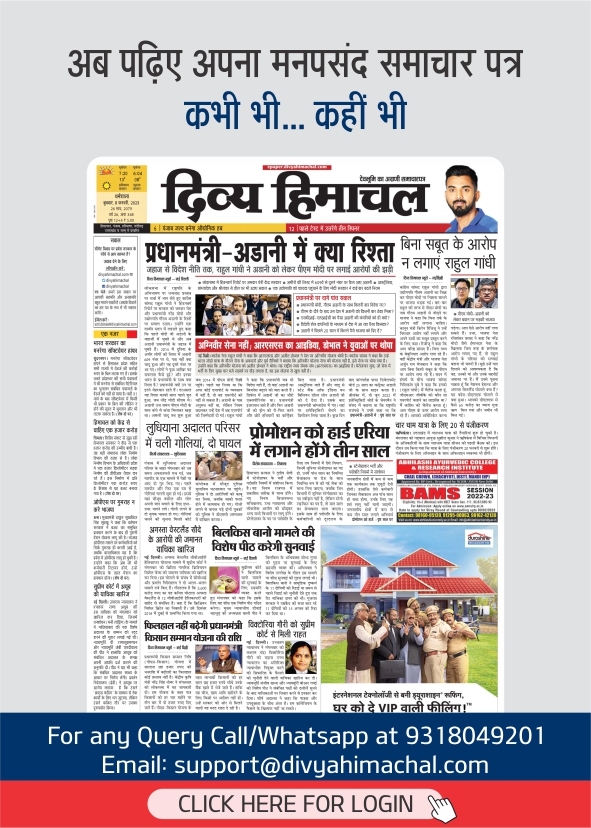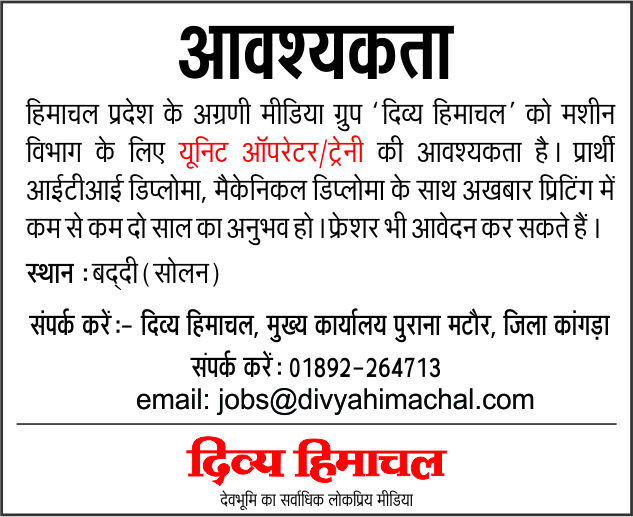Monsoon’s Role In Collapse Of Indus Valley Civilisation
Y.S. Rana
The writer is a Hamirpur based Himachali settled in Chandigarh

Ashish Sinha, professor of earth sciences at the California State University, USA, studying calcite deposits in Sahiya cave in Uttarakhand, gleaned 5,700 years rainfall data using these deposits, stated prolonged droughts that ended two civilizations. New data obtained from deposits made of calcium carbonate dissolved from the surrounding limestone by ground water in an Uttarakhand cave now offer rainfall patterns from 5,700 years ago. The study shows long, deadly droughts ended the Indus Valley and the Vedic era that followed. Two of the nine authors of the study—scientists of India-origin working in China and the USA—tell us why modern India should be concerned about the likely coming of a new great dry period. It states starting 3,400 years before present (BP) when a strong Indian summer monsoon had attracted the influx of Indo-Aryans into the north Indus Valley marking the beginning of the Vedic civilization. Later on with weakening of Indian summer monsoon event around 3100 years BP caused them to shift to other places.
The new study is not the first study to identify climate change as the reason for the fall of the Harappan civilization but it is the first study to reconstruct Indian monsoon precipitation patterns over the last 5700 years by studying calcite deposits—usually composed of calcium carbonate dissolved from the surrounding limestone by ground water in a cave in Uttarakhand. The records reveal a correlation between weak summer monsoons and the periods over which the Indus Valley and Vedic eras are known to have disintegrated.
Both civilizations prospered during climatically stable intervals and disintegrated during years of drought. With the earliest period, between 4,550 years before present (BP) and 3,850 years BP, a fairly wet and warm, climatically stable interval facilitated the expansion of the agrarian communities of the early Indus Valley civilisation into large urban centres marking the civilisation’s mature phase. During an ensuing prolonged dry spell, these sites were abandoned as communities relocated to the eastern precincts of the Indo-Gangetic plain, a region enjoying a heavier monsoon, records the study.
Monsoon Anomalies In Future
“There is a good chance that monsoons which are keys to India prosperity will see anomalies,” also warns the latest assessment report from the Inter-governmental Panel on climate change ((IPCC). The report further states that it is likely the area encompassed by monsoon system will increase over this century means weakening of monsoon. Monsoon precipitation is likely to intensify due to increase in atmospheric moisture.
The Other Thought
But many thought that there might not have been one single reason that drove the demise of Harappan Civilization. Prof A.D. Ahluwalia, former Head, Department of Geology, Panjab University, Chandigarh told Himachal This Week that weakening of summer monsoon might be one of the reasons. The destruction of Indus Valley Civilization cannot linked to weakening of summer monsoon, but may most likely be linked to major earthquake which tilted the Saraswati river bed leading to dissipation of water and destruction of the towns. Floods and droughts are normal cycles of nature and these cannot be the cause of destruction of a huge civilization, he added. The variability in the monsoon is expressed most strongly at its western limit, meaning that any weakening of the system will impact the fringe areas most. The speleothems, or mineral deposits within the cave, are formed from groundwater, so in a broad sense, yes, the variability of rainfall would influence their growth. However, more deeply, we studied the changes in the chemistry of speleothems (technically, the ratio of heavy to light isotopes of oxygen) to determine how their growth has been impacted by variations in the monsoon rainfall. This is what makes us confident of the Indian summer monsoon precipitation record of the last 5,700 years based on the speleothems of the Sahiya Cave.
The destruction of Indus Valley Civilisation can’t be linked to weakening of summer monsoon, but may most likely be linked to major earthquake which tilted the Saraswati river bed leading to dissipation of water and destruction of the towns
-Prof A.D. Ahluwalia, Former Head, Department of Geology, Panjab
University, Chandigarh
Himachal-o-Meter
The state’s ups and downs this week
AIIMS in Bilaspur Gets Centre’s Nod
Bilaspur: The medical centre that remained in hype and limelight during recent Vidhan Sabha elections has finally got the nod of Union Cabinet. Chaired by Prime Minister Narendra Modi, the Union cabinet approved the establishment of All India Institute of Medical Sciences (AIIMS) facility in Bilaspur at a cost of Rs 1,351 crore. The institute will consist of a hospital with a capacity of 750 beds and trauma centre facilities will be completed within 48 months. “It will have a medical college with an intake of 100 MBBS students per year. Nursing college with an intake of 60 B. Sc (nursing) students per year,” said an official statement. The Cabinet further said residential complexes and allied facilities in the hospital would be broadly on the pattern of AIIMS, Delhi. The hospital will have 20 speciality/super-speciality departments, including 15 operation theaters. It will also have an AYUSH Department with 30 beds for providing treatment facilities in traditional system of medicine,” said the Cabinet.
Charity Detained
Jawali: An ambulance van donated to civil hospital Jawali is facing a sort of detainment for the last two years thereby negating the effect of charity for public cause. The patients are being deprived of the emergency travel service. It is reported that the van is in the garage since 2015 with no service and no maintenance. Hospital administration has forgotten the charity. No doubt there is 108 ambulance too in the hospital. But it is on the round most of times to pick the patients. Locals therefore feel that the donated van can ease the p[ressure and provide relief to public here. Locals have taken up the issue before the constituency representative Arjun Singh for redressal. In response the leader has assured people of every possible help. These small steps can achieve solving big concerning health problems in the state. Change for the good is always welcome. Civil hospital Jawali may soon get its ambulance released from the garage.
Keep watching our YouTube Channel ‘Divya Himachal TV’. Also, Download our Android App






 University, Chandigarh
University, Chandigarh






